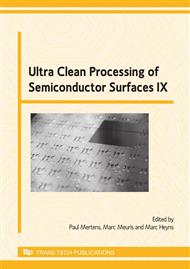p.165
p.169
p.173
p.177
p.181
p.185
p.189
p.193
p.197
Silicon Surface Preparation and Passivation by Vapor Phase of Heavy Water
Abstract:
The well known wet chemical treatments of the silicon surface and its native oxidation in air cause a high density of interface states, which predominantly originate from dangling bonds strained bonds or from bonds, between adsorbates and silicon surface atoms. Therefore, a number of wet-chemical treatments have been developed for ultraclean processing in order to produce chemically and electronically passivated surfaces [1]. The saturation of dangling bonds by hydrogen removes the surface states and replaces them by adsorbate-induced states, which influence the surface band-bending [2]. The first thermal hydrogen desorption peak from a hydrogen passivated Si surface in vacuum or inert gas ambient can be detected at around 380°C [3,4]. Simultaneously the combination of the hydrogen atoms of neighboring dihydrides generates a pair of dangling bonds. At around 480-500°C dangling bonds are generated on the silicon surface by desorption of the remaining hydrogen [5]. At that moment the silicon surface becomes extremely reactive.
Info:
Periodical:
Pages:
181-184
Citation:
Online since:
January 2009
Authors:
Price:
Сopyright:
© 2009 Trans Tech Publications Ltd. All Rights Reserved
Share:
Citation:


